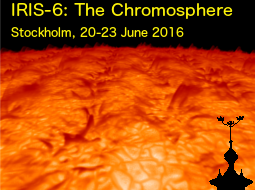Speaker
Bernhard Fleck
(ESA)
Description
Waves and oscillations are interesting not only from the point of view that they can
propagate energy into the chromosphere and dissipate that energy to produce
non-radiative heating, they also carry information about the structure of the
atmosphere in which they propagate. Since the late 80s there is substantial evidence
that the chromospheric wave field is dominated by a non-propagating component,
presumably resulting from wave reflection at the transition region. Observations of
Doppler oscillations measured in the Ca II infrared tripet lines, Ca II K, and He
10830 all show vanishing phase lags (i.e. vanishing travel time differences) between
the various lines, in particular also for frequencies above the cut-off frequency.
Why is the apparent phase speed of high frequency acoustic waves in the chromosphere
so high? Are these results misleading because of complex radiation transfer effects
in these optically thick lines? ALMA, which acts as a linear thermometer of the solar
chromosphere, will provide measurements of the local plasma conditions that should
be, at least in principle, much easier to interpret. Multi-wavelength time series of
ALMA observations of the temperature fluctuations of inter-network oscillations
should allow travel time measurements between different heights as these disturbances
propagate through the chromosphere and thus should finally settle the long-standing
question about the propagation characteristics of high frequency acoustic waves in
the chromosphere. We plan to combine ALMA mm-observations with high resolution IRIS
observations in the Mg II h and k lines, and until ALMA observations are available,
will study the expected signals using time series of mm-maps from 3D radiation
hydrodynamics simulations that are being prepared within the framework of the Solar
Simulations for the Atacama Large Millimeter Observatory Network (SSALMON).
Primary author
Bernhard Fleck
(ESA)

